Every summer resident or owner of a private house faces the problem of installing a new fence. Everyone wants it to be beautiful, reliable, does not require subsequent maintenance and suits the price. The listed requirements are met by corrugated sheet (or profiled sheet) - painted (less often galvanized) or corrugated thin-walled steel sheet covered with polymeric materials. Almost every man can install a fence made of corrugated board with his own hands, without involving outside specialists.
Which corrugated board to choose for the fence
The modern market offers a diverse assortment of profiled sheets, which is divided into three conditional groups:
- C - with a wave height of 8-44 mm. These products are used in the installation of walls, facades and fences, which also include fences.
- Group H is intended for roofing works... Such a profiled sheet has increased bending rigidity due to high (more than 44 mm) waves and a special capillary groove for water drainage.
- NS - universal corrugated board with a wave height from 35 to 44 mm for various purposes.
Simple fence made of corrugated board
The width of the corrugated board is 980-850 mm, it depends on the size of the rolled steel used and the profile of the wave. According to the standards, the thickness of the profiled steel sheet is 0.45-1 mm (taking into account the tolerance, it can be 0.39 mm). The height of the finished sheet is 1.0 m and then every 0.5 m. Directly from the manufacturer, you can order a sheet of any size up to 6 m in length.
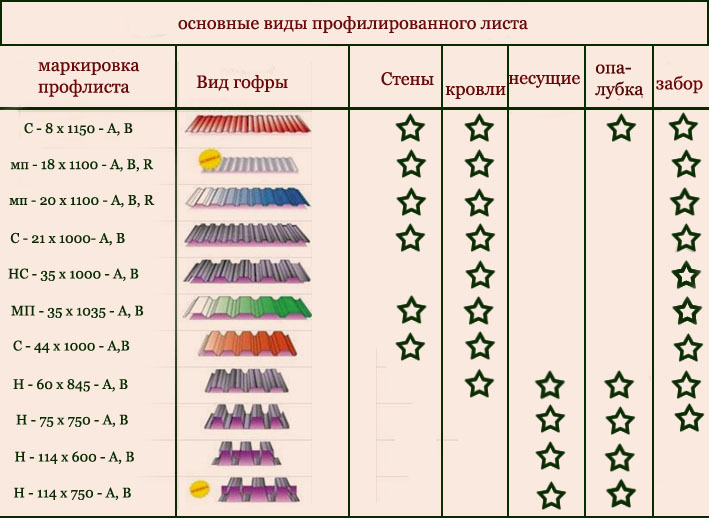
Types of professional sheet and their application
The covering of the corrugated board is multilayer (except for the cheapest option with a single zinc layer) and is conventionally divided into three groups:
- Zinc coating is the cheapest, with the shortest service life.
- A zinc-aluminum coating made from a mixture of zinc and aluminum with improved performance.
- The polymer coating is the most relevant, consisting of:
- polyester with a matte or glossy structure for use in medium temperature ranges;
- purala (blends of polyurethane and polyamide) with increased UV resistance;
- plastisol based on polyvinyl chloride (PVC) for use in difficult climatic conditions;
- a certain kind of composites.
The range of colors is very wide. From well-known manufacturers (for example, Ruukki), the color of the coating can be ordered from the RAL and RR catalogs. The profiled sheet with prints imitating wood, stone or brickwork looks interesting.
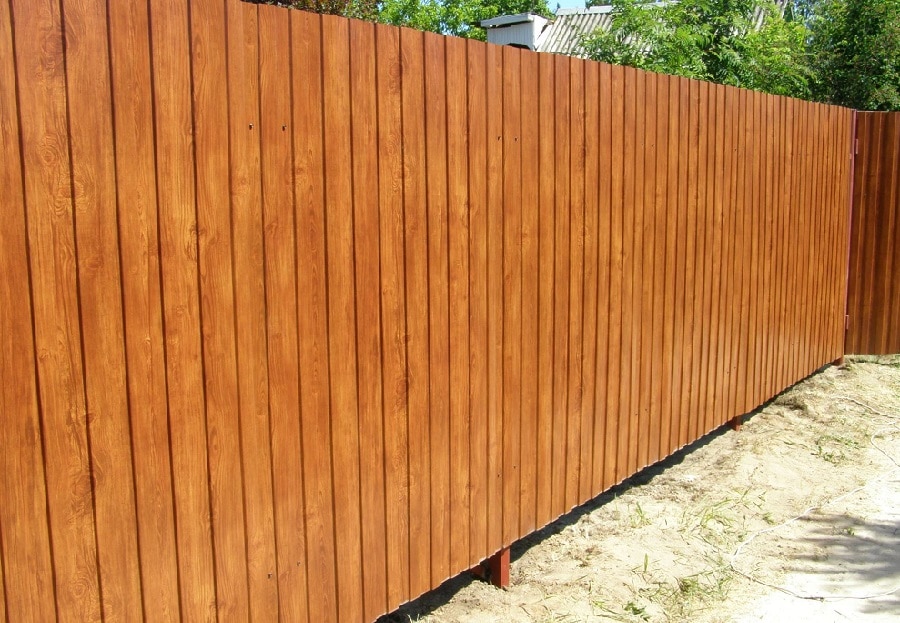
Fencing made of profiled sheet for wood
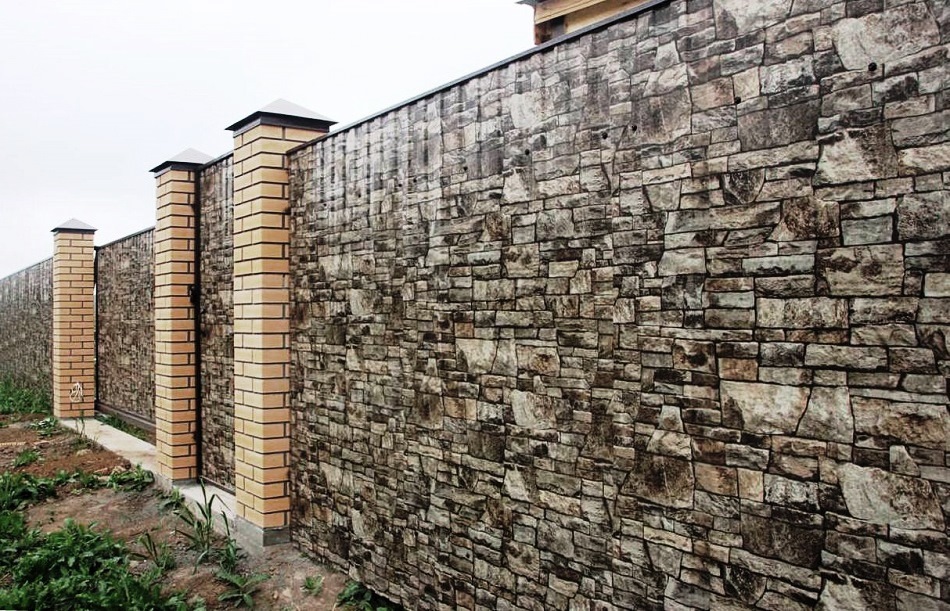
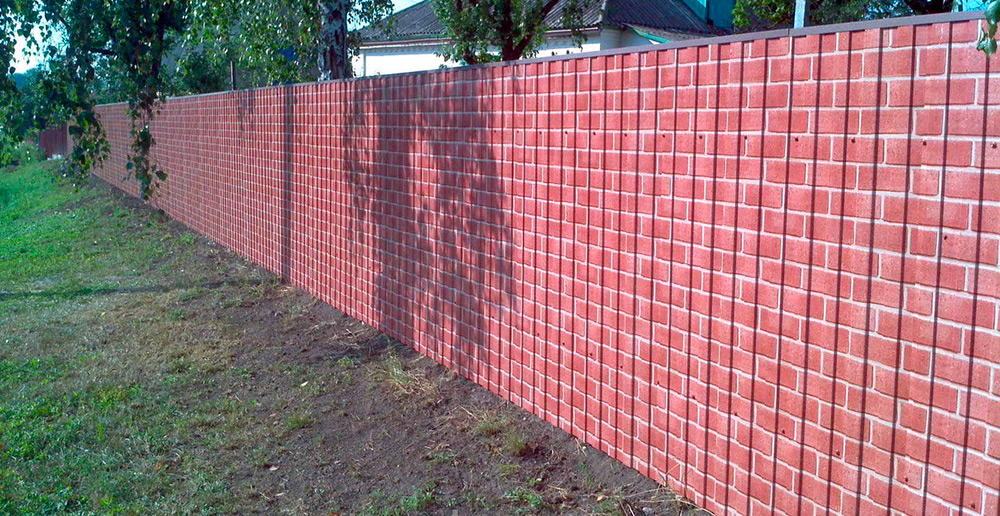
"Brick" metal fence
The parameters described above affect the appearance of the fence, its service life (from 20 years and above) and differ significantly in price. To make a fence from a profiled sheet with your own hands, it is important to choose an acceptable combination of price and quality of the material. Experts consider corrugated flooring with polymer coating brands SP10 and SP20.
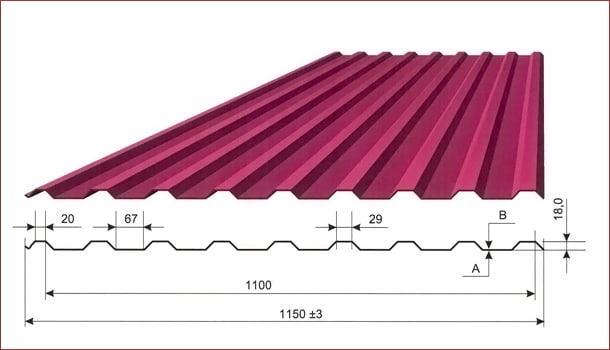
The technology of installing corrugated fences
You can hire specialists, but it is quite possible to make a fence from a profiled sheet with your own hands with racks from a metal pipe. This task does not require supernatural skills and rare tools, and you can save from 20 to 50% of the cost of the material - that's how much the work costs.

Fence scheme on racks
Calculation of professional sheets and racks for building a fence
To determine the amount of corrugated board, it should be remembered that each sheet is overlapped by the next, and the useful sheet width is 40-80 mm less than the real one. The height is selected depending on the wishes and the availability of the foundation.
As a lag (jumpers) for attaching the profiled sheet, a profile pipe 40 * 20 mm is used. It is believed that when using the SP20 profile, two logs are required with a fence height of up to 2 m and three at a higher height. The optimal distance from the lags to the edge of the profiled sheet is 300 mm.
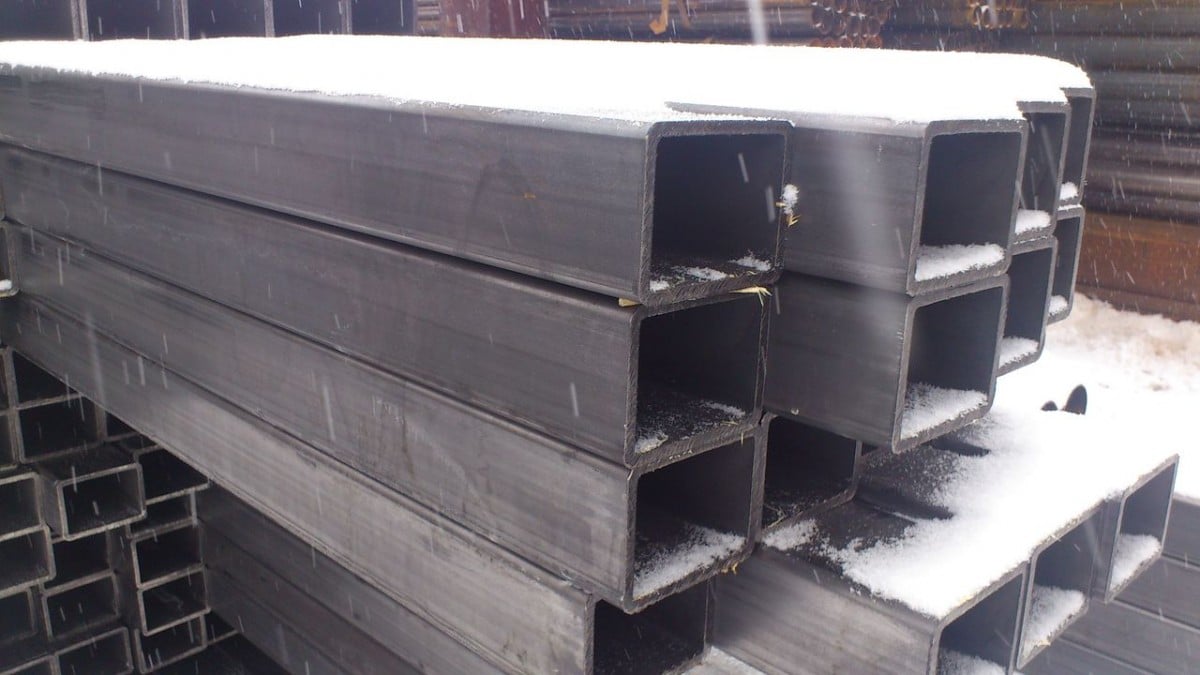
Racks (supports) for supporting structure can be of various materials. It is better to use a square metal pipe with a side of 60 mm or more. The distance between the posts is 2-2.5 meters. To calculate the number of racks you need:
- Measure the length of the fence, then divide by 2.5.
- Round up the resulting amount (there are 2 more racks in total, taking into account the corner ones).
- Calculate the height of the supports taking into account the fact that 30-40% of the length should be in the ground. Therefore, for a fence with a height of 2 meters, the length of the rack will be: 2 + 0.35 * 2 \u003d 2.7 m (approximately).

Racks of shaped pipe with heel
Fasteners and strips for ends
The number of fasteners (screws or rivets) is calculated taking into account the fact that two extreme sheet waves and middle waves are attached to the logs through one. That is, one sheet of SP20 is attached at six points. Rivets (the most popular 4 * 20 mm) and self-tapping screws (preferably 4 * 25 mm) come in different colors, which allows you to pick them up to match the fence. It is preferable to use self-tapping screws with rubber-coated washers, this prevents damage to the profiled sheet during installation and loosening of the fastening during operation.

The decorative U-shaped strip serves to frame the end of the fence, gives a finished look and protects the profiled sheet from rust. It is better to use a strip with rolled edges - it is stronger and does not damage the coating during installation. The length of the slats is 2 m, they are installed overlapping each other (30-50 mm) along the entire length of the fence.
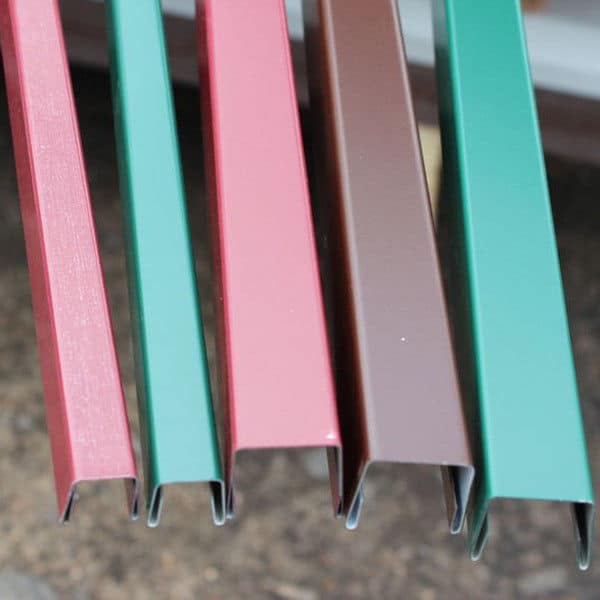
Decorative U-shaped strip
It is useful to purchase an aerosol can with paint of the appropriate color to eliminate possible scratches and scuffs on the profiled sheet. To protect the supporting frame, you will need soil and paint (better than neutral gray into the background of the back side of the fence).
For cooking concrete mortar will be needed in required quantities sand, crushed stone, cement (in the transition period of the year - a plasticizer).
Construction Tool Set
To install a fence made of corrugated board with your own hands, you will need the following tools:
- a drill and a shovel for digging holes for racks;
- concrete mixer;
- angle grinder ("grinder");
- a welding machine for attaching the lag to the racks (there are other mounting options, but you should not consider them due to the complexity and unreliability);
- drill or screwdriver;
- riveter (when using rivets);
- scissors for metal;
- painting tool (for painting the frame);
- measuring tool (tape measure, thread, bubble and hydro level).
In no case should you neglect the labor protection requirements! When working with a power tool, protective goggles and comfortable work clothing are required. Use a protective shield when welding. The profiled sheet itself is very sharp and you need to work with it with gloves.

You need to work in protective clothing
Frame racks installation technology
To understand how to properly install a fence made of corrugated board with your own hands, you should understand the principles of mounting the supporting structure. The initial stages of the construction of the frame are its marking, binding to the terrain, determining the type of soil and choosing the method for installing the racks.

- Install the end and corner posts first. They must be at the same height, which is controlled by a hydro level. If the length of the level is not enough, you need to use any intermediate pole or support.
- Racks can simply be hammered into the ground, but it is better to concrete them. To facilitate the alignment of the posts in height, the bottom of the prepared pits is covered with gravel or sand, and it is better to equip the rack itself with a heel - a flat platform that facilitates installation.
- It is imperative to control the verticality of the racks using a bubble level during and after installation.
- Concrete on top of the ground is best tapered to allow water to drain off and prevent accumulation at the base of the post.
- If the length between the extreme posts is divided by the number of intermediate posts, you get the exact distance between the centers.
- After the concrete has hardened and markings, holes are prepared for intermediate racks.
- Pull the thread over the top of the already installed props (height control), the top and bottom of the props (control of being on the same straight line).
Similarly to the angular ones, intermediate posts are installed, while alignment is mandatory in one plane and height, respectively, to the tensioned threads. The height of the supports is adjusted by adding or removing a gravel (sand) pad.

To prevent moisture from entering the inside, the top of the racks must be welded with metal plugs (it is easier to do this before installation), or use special plastic ones.
As a budget option, you can use the same parts of plastic bottles with bottoms. After putting it on the rack, the bottle is evenly warmed up with a building hair dryer, decreasing in size and very tightly fitting the pipe. It looks interesting and stylish, it is almost impossible to recognize the original object in such caps!
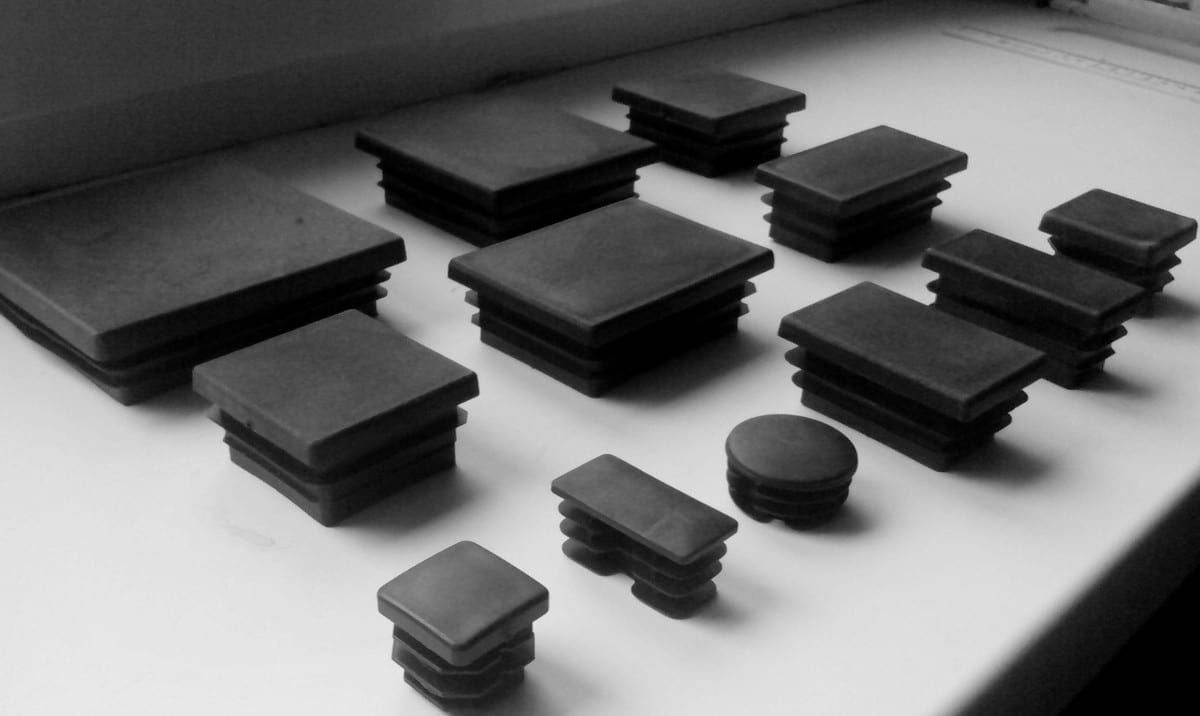
The technique of attaching the lag to the supports
After the concrete has hardened, logs are attached to the supports using electric welding. For a fence with a height of 2 m, the upper log should be located at a height of 0.3 m from the top of the racks, the lower one - 1.7 m. It is easier to splicate the logs along the length in advance, controlling the parallelism of the parts to be welded, or in the center of the racks. It is mandatory to control the installation horizontally using a level.
After fixing the lag in the welding places, remove the slag, if necessary, clean the surfaces with a grinder. Treat the entire frame with soil and then paint, since after installing the profiled sheet it will be much more difficult to do this.
With a significant slope of the surface of the land plot, the racks and logs are placed with an offset in height. You can shift each span or through several sections, but always by one amount and the same number of spans!
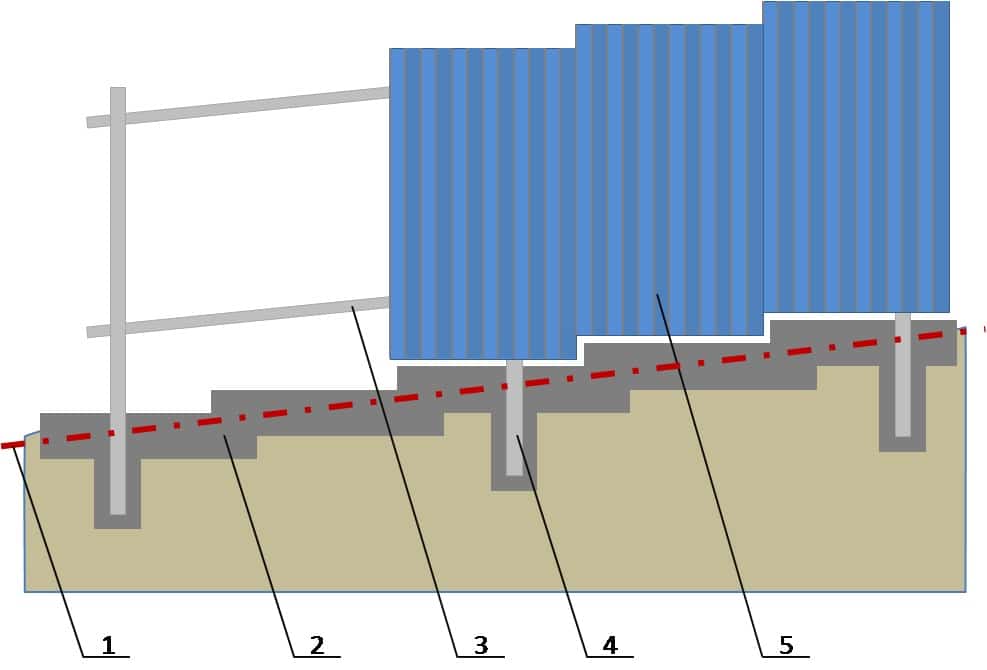
Installation and fastening of the profiled sheet
Directly attaching the sheet to the frame is the final operation in the construction of a fence from corrugated board with your own hands. Considering that the logs are located strictly in level and at the same distance from each other, even before installation, it is necessary to calculate and mark on the profiled sheet the places for fasteners with a marker or a soft pencil.
The first sheet is leveled strictly and attached to the logs. Subsequent sheets are overlaid and attached with interception in one wave. Periodically, you need to check the verticality of the material to be fixed (the height is set by the first sheet).
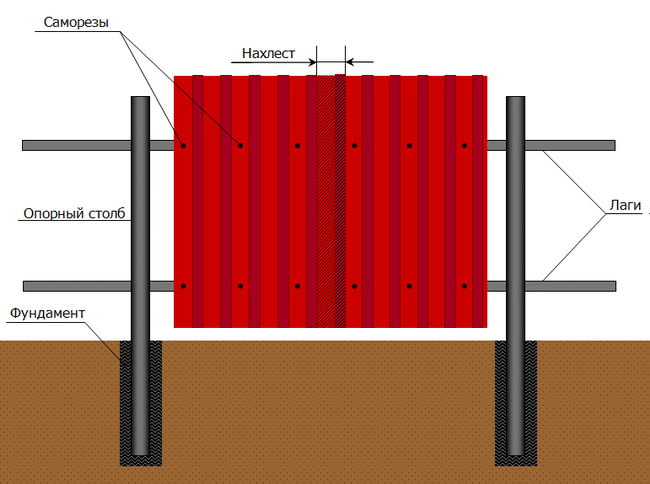
Installation diagram of a fence made of profiled sheet with posts
If there is a clear shift in level, it is possible to correct the situation on the next 2-3 sheets by fixing one side of the corrugated board and slightly stretching the desired unfixed corner. You can pull the sheet just a few millimeters, but often this is enough so as not to dismantle the fence and start the operation again.
If you need to trim the corrugated board, it is better to use metal scissors. Use the "grinder" only as a last resort, since there is a high risk of damage to the material, burrs are formed, and the cut edge quickly rusts.
It is not necessary to put the sheet directly on the foundation (if available) during installation! It is better to leave a gap within 10 mm to prevent the profiled sheet from getting wet and corroded.
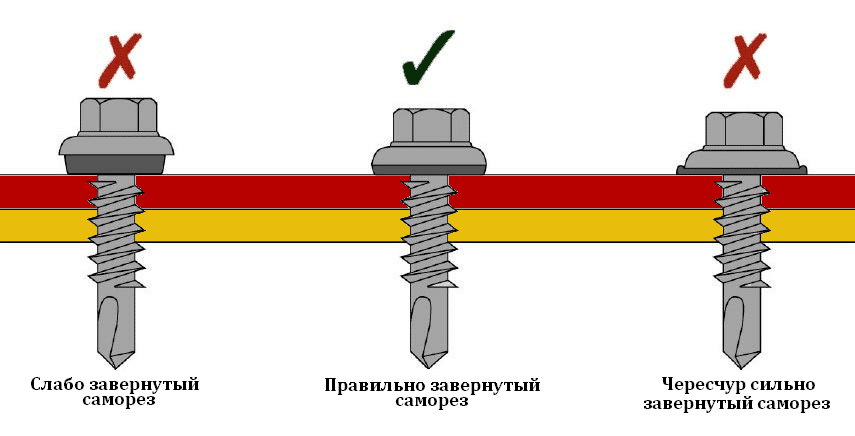
It is important to tighten the self-tapping screw correctly
Do not clamp the screws too tightly in order to avoid deformation of the rubber layer of the washer; it is better to use a screwdriver with a selected tightening torque. After installation, it is imperative to remove the protective film (if any), since after a few months it will partially adhere to the surface, and in some places it will crumble, giving the fence an untidy spotty look. The final stage is the installation of the decorative strip.

"The wrong side" of the fence
How to build a fence with a strip foundation

Installation of a fence with a foundation
To prevent damage to the bottom of the profiled sheet, the formation of rust when it comes into contact with the ground and to give the fence an aesthetic appearance, a foundation is used. Making a fence from corrugated board with a foundation with your own hands is more difficult, but also quite feasible. In fact, this is an ordinary shallow strip foundation with an optimal depth of 300-400 mm and a plinth from 100 mm in height. The width of the foundation is not regulated, 200 mm will be enough
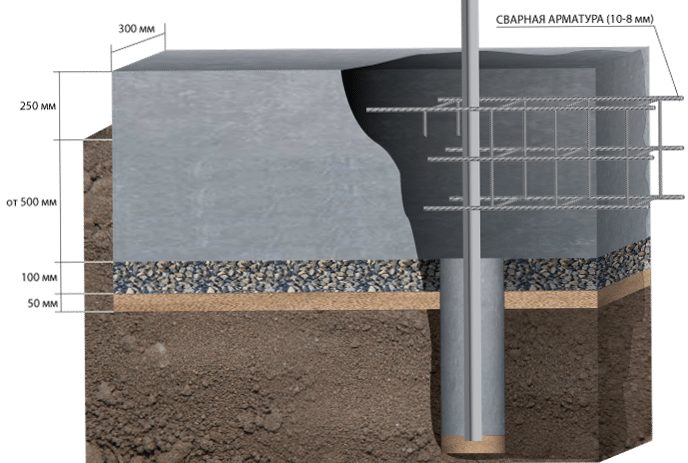
To make the foundation between the installed racks, you need to dig a pit of the required depth, then make and install the formwork. Since the plinth will be visible, it is better not to skimp on formwork material. An OBS-plate is well suited for these purposes, and even better - film faced plywood, and these materials can be used repeatedly, pouring parts into the formwork.
The technology itself is no different from pouring a strip foundation for a gazebo or other structure. Easier and faster work will progress using a concrete mixer. To give the foundation strength, it is advisable to use reinforcement, at least several threads are welded to the racks.
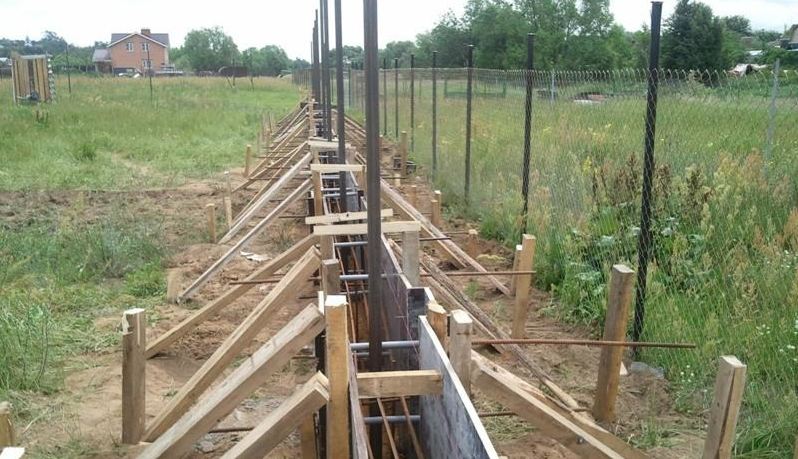
Formwork for pouring the foundation
Installation of a sectional fence with columns
The most beautiful, but also the most expensive construction of a section-type fence, where the sections are separated by columns (pillars). To build a fence made of corrugated board with columns with your own hands, you should first decide on the design and choose required material... It can be facing brick, natural stone, special decorative blocks. There are many options for the design of columns and foundations, you only need a reasonable imagination and some skills of a bricklayer.
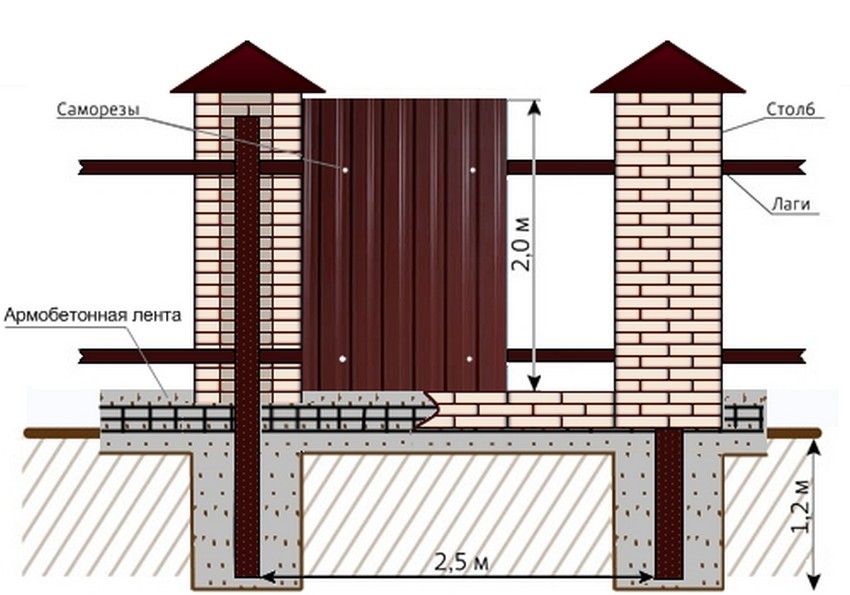
Fence scheme with columns
The pillars can be laid out as independent units or overlaid the installed metal racks, thus modernizing the option of a fence with a foundation. But, in any case, the foundation for the columns should be much more powerful and massive, since the columns themselves have an impressive weight. Be sure to reinforce the foundation, preferably in two rows. When laying around the support, you need to pour concrete into the voids between the support and the brick.
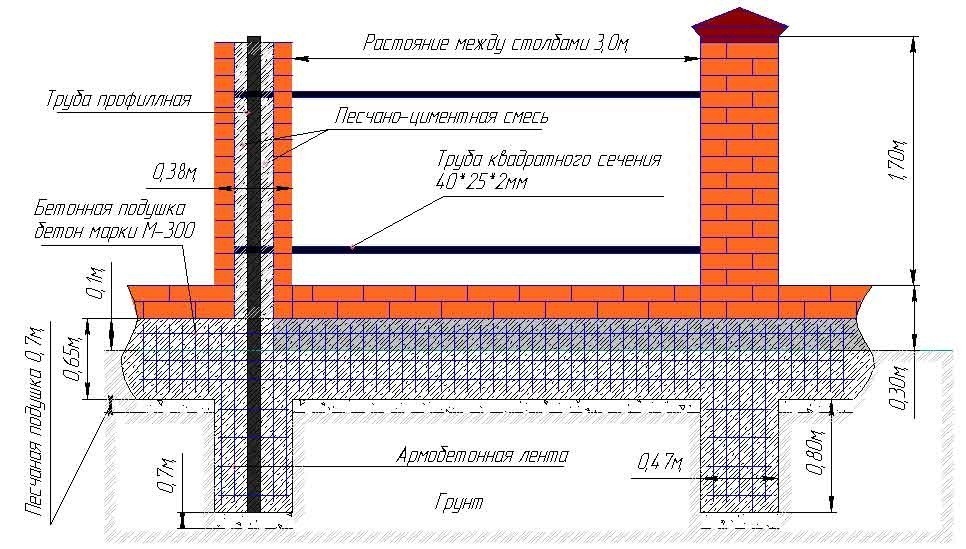
Fencing scheme with columns and foundation
If the posts are built without a ready-made fence frame, it is imperative to provide embedded metal parts for the subsequent fastening of the lag, while strictly maintaining the level horizontally (both the posts themselves and the embedded parts).
Columns should be erected only after the foundation has dried; it is recommended to lay out no more than 500 mm of a column in height per day. Every third row of bricks is reinforced with a metal mesh for strength, the seams should be even and of the same size.

To reduce material consumption and facilitate installation, it is recommended to accurately calculate the distance between the posts so that a certain number of profiled sheets (usually 2 or 3) can be placed in it without cutting. The top of the column must be covered with a ready-made decorative cap or made conical to drain the water.
As you can see, the task of how to build a fence from a professional sheet with your own hands is not too difficult. This can be done by anyone with the skills to work with metal and concrete. Of course, you can always invite a specialist, but an impeccably performed work on your own will delight you. long years!
Video: corrugated fence
Recently, the use of profiled sheets in the construction of fences and fences has become very popular. Market building materials saturated with profiled sheets of various colors and strengths to create an attractive and reliable fence.
The professional sheet has a number of advantages over stone, concrete and other structures. Firstly, the profiled sheet is covered with galvanized and polymer coating, which protects the material from the effects of weather and sunlight. This in turn increases the service life of the profiled sheet. Secondly, the cost of installing the structure and the material itself is much lower than other analogues. At the same time, any fragment of the fence from the profiled sheet can be easily replaced if the old one has become unusable. Thirdly, the profiled sheet fence has a high level of sound insulation. Profiled sheets are very easy to use and do not require additional maintenance.
Another advantage of this material, is that a fence from a professional sheet can be easily made with your own hands, significantly saving on the services of masters.
Preparatory stage
Starting to install a fence from a profiled sheet with your own hands, you need to measure the perimeter of the fenced area. This is necessary for accurate calculation. supplies: support pillars, logs, profiled sheet, concreting mixture. It is important to remember that the support pillars must be chosen according to the height of the fence plus 1.5 m for their further concreting. After that, we proceed to marking the territory, hammering in a peg at the installation site of the support pillars. Pull the rowing cord between the pegs in order to installed fence turned out to be smooth and straightforward. After that, you can start digging holes 1-1.5 m deep and 0.2-0.3 m in diameter.
Installation stage
After finishing preparatory phase, proceeding to the installation of support pillars. A variety of materials are used as supports: pipes, channels, concrete, stone pillars. It is recommended to choose rectangular posts, since it is easier to attach logs and profiled sheets to them.

The post is installed in a dug hole, 1-1.5 m in size, followed by concreting. It is recommended to concrete the supports deeper than 1.5 m to avoid further overturning or deformation of the fence. At the same time, in order to firmly install the pillar, the concrete mixture must contain 3 times more crushed stone than cement, and 1.5 times more than sand. To install the support level, you must use a level. The next support is recommended to be installed at a distance of 2 m. The concrete drying period is 3-4 days, only after this period you can proceed to further actions. Also important on this stage close the top of the posts to avoid water accumulation inside the structure.
After installing the pillars, you can start installing the lag. The number of lags depends on the height of the fence. At a height of 1.5-1.8 m, two logs are enough, but if the fence is higher, an additional rail must be installed. The log is attached to the support posts by welding, parallel to the ground, with an indent of about 0.3-0.4 m from it. If, however, this unit is not there, you can mount the logs using bolts, but such a fastening will be less reliable.
After completing the installation of the frame, you can proceed directly to the installation of profiled sheets. Profiled sheets are attached to the logs using self-tapping screws or rivets, setting each sheet with an overlap of 1 wave. In this case, the distance between the fasteners should not exceed 0.2-0.25 m.
The final stage of installing a fence from a profiled sheet with your own hands is additional processing of the attachment points. To protect the welding site from corrosion, screwing in self-tapping screws, rivets, it is necessary to treat with a primer, followed by painting them in the color of the fence. If scratches appear on the profiled sheets during the installation of the fence, they also need to be covered with a double layer of enamel.
Following the instructions and taking into account all the details, assembling a fence from a profiled sheet with your own hands will not seem like a difficult task. A well-installed fence will fulfill its aesthetic and protective purpose for a long time to come.
Do-it-yourself video review of installing a fence made of corrugated board
Many construction teams undertake the installation of a corrugated board fence. The process is not troublesome and fast, but substantial earnings.
You can eliminate this expense item from the general estimate for the improvement of a summer cottage or a private house by deciding to make a fence from corrugated board with your own hands.
The purpose of the fence on the site is to fence the territory. At the same time, it also has another function - a representative one.
Previously, the main material for the construction of fences was wood - an affordable material, but requiring maintenance and protection from destruction, now other building materials also compete with it: brick, concrete, polycarbonate, mesh, forging, corrugated board.
According to the ratio of the parameters "price-installation-durability-appearance", the leadership belongs to the corrugated board, which led to its wide distribution among users.
Advantages of corrugated fences
- ease of material and installation;
- strength (rigidity);
- corrosion resistance;
- uniform and very slow fading (like paint on a car);
- aesthetic appeal;
- undemanding care;
- long service life;
- relatively low price.
Few building materials have such a list of advantages. But, all these properties are fully revealed only when correct installation... So, you need to know how to make a fence from corrugated board correctly. Within the limits of the article, we will talk about the nuances of choosing a material, the specifics of its calculation, types of frame for a fence, we will describe how to attach corrugated board and much more.
DIY fence made of corrugated board -
step-by-step guidance from A to Z
Installation of a fence made of corrugated board, includes only screwing the sheet to the frame, this is a process consisting of several stages. We will describe each of them in detail in the form of step-by-step instructions.
Stage 1. Fence scheme from corrugated board - from sketch to drawing
An arbitrary schematic drawing (sketch) is needed in order to visualize the design features of the fence.
There are two types (types) of corrugated board fence:
- solid;
- sectional.
 It is the type of fence that determines the consumption of material and the methods of installing structural elements.
It is the type of fence that determines the consumption of material and the methods of installing structural elements.
The following is applied to the drawing:
- the location of the fence on the site. Helps to take into account the features of the site: relief, plantings, buildings, driveways, gate installation location, etc.;
- if the site is uneven (hill, lowland), apply a place where there will be elevation differences. Producers producing high-quality material produce profiled sheets with a length multiple of 50 mm. this allows you to achieve visually the same fence height, despite the differences in height along the ground.
- dimensions: the height of the fence and the length of individual straight sections;
- the location of the columns (supports);
Note. When sectional fence the width of the section is determined by the width of the sheet. It must be a multiple of 1, 1.5, or 2 sheets.
A detailed diagram simplifies material calculation.
Stage 2. Materials for a fence made of corrugated board
Construction will take place quickly if the materials required for manufacturing are timely prepared.
What materials are needed for a fence made of corrugated board:

1. Decking
When choosing a profiled sheet (goforolist), you need to pay attention to the thickness (0.45-0.5 mm +/- 0.06 mm), wave height, absence of capillary groove, parameters, coating, color and texture.
The profiled sheet has a high windage, this must be taken into account when planning the frame.
Note. The dimensions of the profiled sheet for the fence differ in different manufacturers, this must be taken into account when choosing a material. It is also worth knowing that the warranty period for galvanized corrugated board is 20-30 years, and with polyester coating - up to 50 years (depending on the layer thickness).
2. Supporting posts (posts)
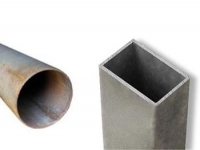 In theory, any material can be used: wood, stone, metal.
In theory, any material can be used: wood, stone, metal.
When deciding which posts to use for a fence, keep in mind that the simplest and most affordable option is metal pipes.
Rack parameters depend on the expected load. Usually pipes 60x40x2 mm or 40x40x2 mm are used. For round pipes diameter - 60-100 mm.
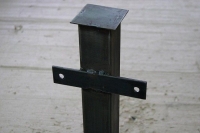 You can use purchased ready-made pipes for the fence (photo) (for any type of soil) or piles (normal soils and loams).
You can use purchased ready-made pipes for the fence (photo) (for any type of soil) or piles (normal soils and loams).
The advantage of ready-made support pillars is the presence of a "heel" for installation on a pillow, holes for fixing corrugated board and an upper plug, which prevents water from entering the pillar.
3. Transverse logs
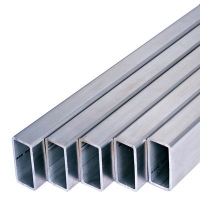 For lags (crossbars), it makes sense to use square pipes 40x40x2 mm. or 40x20x2 mm. General recommendation - the width of the log is equal to half the width of the support post.
For lags (crossbars), it makes sense to use square pipes 40x40x2 mm. or 40x20x2 mm. General recommendation - the width of the log is equal to half the width of the support post.
It is unacceptable to use wooden logs, due to the fact that the wood tends to rot at the point of attachment of the sheet. This will not only reduce the service life of the fence, but also prevent the sheet from being reused. The metal corner is also not suitable for logs, with a thickness of 2 mm it will not provide adequate resistance to wind load, and manufacturers do not recommend using a thicker one.
Note. A special self-tapping screw for corrugated board with a drill is designed for drilling metal with a thickness of not more than 2.5 mm. So the use of a thick-walled profile is fraught with additional drilling efforts.
4. Plate holder (bracket) for corrugated board
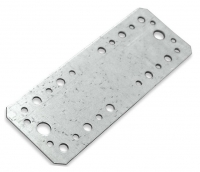 He uses special fasteners (brackets) when assembling the frame of the fence using a non-welding method, for hardware.
He uses special fasteners (brackets) when assembling the frame of the fence using a non-welding method, for hardware.
5. Caps for posts (supports)
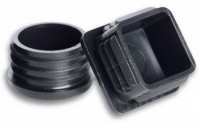 Plastic plugs have a protective function to prevent water from entering the pipe.
Plastic plugs have a protective function to prevent water from entering the pipe.
In practice, the post is covered with a special pad or a plastic bottle. Not very aesthetically pleasing, but certainly cheap and useful as a temporary solution to the problem.
6. Hardware
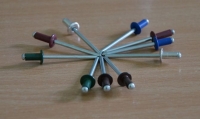 Needed for welding-free assembly of the fence frame. For this, a bolt or screw M6 (30 and 20 mm) is used. And also self-tapping screws for fastening corrugated board or rivets.
Needed for welding-free assembly of the fence frame. For this, a bolt or screw M6 (30 and 20 mm) is used. And also self-tapping screws for fastening corrugated board or rivets.
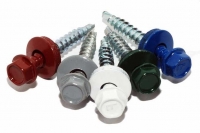 Professionals advise using a self-tapping screw, because it is equipped with an additional gasket (neoprene rubber), which allows you to firmly press the profiled sheet without damaging its surface. Its length is 15-35 mm.
Professionals advise using a self-tapping screw, because it is equipped with an additional gasket (neoprene rubber), which allows you to firmly press the profiled sheet without damaging its surface. Its length is 15-35 mm.
Council. When using rivets, the edges of the holes for them are recommended to be treated with a special paint. This will prevent the rapid appearance of rust at the attachment point and the formation of rusty smudges on the corrugated board, which are very difficult to eliminate.
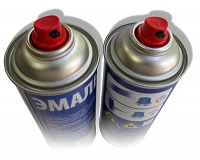 The paint is used to touch up scratches that may appear during the installation of the profiled sheet, as well as to paint over the cut on the sheet. Consumption is low, as a rule, one spray is enough.
The paint is used to touch up scratches that may appear during the installation of the profiled sheet, as well as to paint over the cut on the sheet. Consumption is low, as a rule, one spray is enough.
8. Decorative end strip for decorating the fence
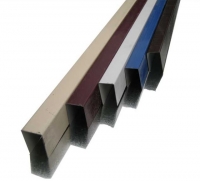 U-shaped strip (intake, cover), which is installed on the upper edge (edge) of the profiled sheet and protects users from possible cuts, and the sheet from rust.
U-shaped strip (intake, cover), which is installed on the upper edge (edge) of the profiled sheet and protects users from possible cuts, and the sheet from rust.
Material prepared for the site www.site
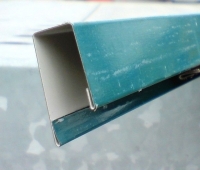 Note. When buying, pay attention that the edges of the plank should be folded (rolled). Otherwise, they will not only scratch the metal during installation, but will lose their shape (the edges will move away from the sheet) during operation.
Note. When buying, pay attention that the edges of the plank should be folded (rolled). Otherwise, they will not only scratch the metal during installation, but will lose their shape (the edges will move away from the sheet) during operation.
Additional materials and tools:
- cement, gravel, sand - for installing support pillars or arranging a foundation;
- level, plumb line, welding machine (and consumables), screwdriver, mortar containers, formwork boards (if necessary), shovel or drill, primer and anti-corrosion solution for metal, riveter (if necessary), rope, goggles and gloves, grinder (if necessary, cutting profiled sheets).
Stage 3. Calculation of material for a fence made of corrugated board
How to determine how much building material is required for manufacturing.
1. Calculation of the number of sheets of corrugated board:
- at solid fence - the total length of the fence is divided by the useful width of the sheet. Rounding goes up;
- with sectional. If the size of the section (span) is equal to the width of the sheet, the total width of the sheet is used. If it is planned to install one and a half or two sheets there - useful.
Note. The sheet can be installed both vertically and horizontally. When horizontal mount the height of the fence will be equal to 1, 2 or 3 working widths of the sheet. In case of vertical - it is determined by the customer.
Council. When calculating, do not operate with such a concept as the total area of \u200b\u200bthe required corrugated board. Calculate in pieces at a given sheet height.
2. Calculation of the number of posts for a fence made of corrugated board
The number of supports depends on the distance between the posts of the fence made of corrugated board
- with a solid fence, the total length of the fence is divided by the estimated distance between the posts (posts). Taking into account the windage of the sheet, it is taken equal to 2,000 - 3,000 mm. It is impractical to increase the distance, since this will lead to an increase in the thickness of the racks or the number of longitudinal lags.
- with sectional. The number is determined by the expected number of sections. When installing racks for mounting fence sections, you need to calculate the distance between the posts in advance so that it corresponds to the total (when installing one sheet in a section) or useful (1.5-2 sheets) corrugated flooring area.
Note. The calculations take into account that the support posts (pillars) must be installed at the corners of the fence, as well as at the installation site of the gate and / or wicket. The number of intermediate supports is rounded down. And the difference is compensated by the deviation from the specified distance between the posts.
The size of the post is determined by the height of the fence, assuming that the posts go 30% of their length into the soil. Thus, with a fence height of 2,000, the height of the support post for a corrugated board fence should be 2,600-2,700. For intermediate posts, an installation depth of 25% of the total fence height is permissible. Then the length of the post is 2,500 mm.
3. Calculation of the number of transverse lags
The amount depends on how the fence is installed.
- Masters advise using 2 logs with a fence height of up to 2,000 mm. Moreover, their distance from the edges of the corrugated board is 300 mm.
- With a fence height of more than 2000 mm - 3 logs.
 Thus, the total timber lag is determined by multiplying the total length of the fence by the number of crossbars.
Thus, the total timber lag is determined by multiplying the total length of the fence by the number of crossbars.
4. Plate holder
The number of plates is equal to the number of support posts multiplied by the number of lag rows.
5. Cap for a post
The number of plugs is equal to the number of support legs. Plus 2-3 spare (useful during the operation of the fence).
6. Hardware
When calculating self-tapping screws, it is taken into account that the fastening is performed in two extreme waves and through two in the middle of the profiled sheet into each of the transverse lags. Thus, with two transverse lags per sheet, 6 pcs are required, with three - 9 pcs. The number of hardware is rounded off in multiples of packaging (standard packaging - 250 pcs). Since, in the process of tightening the self-tapping screw, defects may occur.
When fastened with rivets, their consumption increases, since they are fastened along the edges and through the wave.
Standard paint packing 50, 100, 200, 500, 900 gr. The choice depends on the length of the fence. Usually 50 gr. banks are enough.
8. Decorative end strip
The amount is equal to the length of the fence divided by the working length of the bar. The standard length of the bar is 2000 mm, the working length (taking into account the overlap) is 1850-1950 mm.
Stage 4. Installing a fence made of corrugated board with your own hands
Installation technology step by step:
1. Site preparation
Cleaning the soil surface from everything that will interfere with the installation of sheets and poles.
2. Construction of the foundation and / or installation of support posts
Note. The destruction of a sheet of corrugated board begins at the point of contact with the surface of the soil. Pebbles, dirt, mechanical damage lead to the appearance of defects precisely at the bottom of the sheet. In addition, the uneven terrain of the site often makes it difficult to install supports. That is why the foundation for a fence made of corrugated board is a mandatory stage in the construction of the fence.
What is the best foundation for a corrugated board fence?
To decide on what foundation to put a fence from a profiled sheet in a specific area is usually helped by soil research. But since a fence made of corrugated board is a relatively light construction, a regular one is suitable for it. Its optimal depth is 300-400 mm, and minimum width foundation for a fence made of corrugated board, is determined by the width of the support post (columns).
We will not dwell on how to fill the foundation. But let us note such a nuance, the depth of the pit in the place of installation of the basic support posts (along the edges of the fence, corners, in the place of installation of the gate) should be 1/3 of their height + 100-150 mm for the device of a pillow under the foot of the post. For intermediate posts - 1/4 of the support height + cushion height. This will remove the influence groundwater and soil freezing on the rack.
The preparation and installation of formwork is no different from arranging a strip foundation for a house or a gazebo.
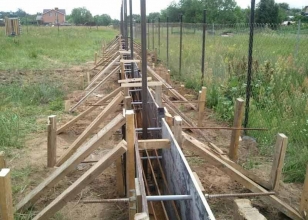
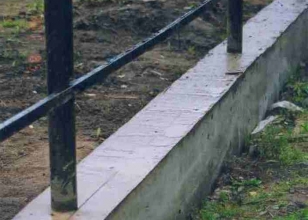 First of all, basic support posts are installed (along the edges of even segments of the fence), a rope is pulled between them and intermediate posts are installed along it. At the installation site of the support posts, the soil is taken out with a drill, a gravel-sand cushion is poured onto which the posts are installed. In this case, metal pipes should be treated with an anti-corrosion solution.
First of all, basic support posts are installed (along the edges of even segments of the fence), a rope is pulled between them and intermediate posts are installed along it. At the installation site of the support posts, the soil is taken out with a drill, a gravel-sand cushion is poured onto which the posts are installed. In this case, metal pipes should be treated with an anti-corrosion solution.
Users note that it is better to concrete the racks by 100-150 mm. So they remain stable when reinforcing the formwork and filling it with concrete. If you plan to ram the pillars, then the pillow should be made 200-250 mm high and the racks should be hammered into it. This method is more time consuming, but less costly and reliable.
Council. The use of a level and a plumb line when installing racks is mandatory.
A simpler option would be to install support posts without arranging a foundation. Installation requirements are similar. The depth is equal to 1/3 or 1/4 of the length of the rack, depending on the place of its installation, the thickness of the gravel-sand cushion is 100-150 mm, mandatory treatment with an anti-corrosion mortar, level check and reliable concreting.
Note. In practice, fence posts made of corrugated board are installed with deviations from the above technology. This is justified in stable soils.
Alternative ways of installing the racks are shown in the diagram.
![]()
3. Mintazh lag
Fastening of corrugated board is carried out on transverse joists. They are mounted on the support posts after they are securely concreted. In this case, it is impossible to rush work, because this can lead to deflection of the stand from the vertical.
The transverse joists can be welded or screwed onto the support legs. Masters recommend using a holder plate (bracket) for these purposes. Thus, the plate is screwed to the support post, and the lag to the plate, this makes the project a little longer and more expensive, but the fastening is considered more reliable.
Three ways of attaching the lag to the support posts (photo)
 - in front of the pillar butt... The method is ideal for the construction of solid fences;
- in front of the pillar butt... The method is ideal for the construction of solid fences;
- behind the pillar using the holder (crown). Suitable for sectional fences;
- side of the pillar... The advantage of the method is that it is possible to fasten the corrugated board not only to the log, but also to the support post, which makes the structure more stable. But, the duration of work and the consumption of self-tapping screws increases. Suitable for sectional fences.
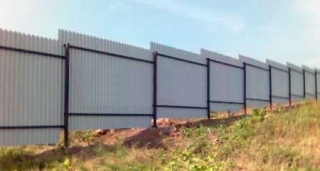 Note. With a significant slope of the site, the transverse joists are mounted with an offset, as shown in the photo.
Note. With a significant slope of the site, the transverse joists are mounted with an offset, as shown in the photo.
The finished frame is coated with anti-corrosion primer and paint.
4. Decorative design of columns
This stage is possible only if a sectional type of fence is selected from corrugated board. Here, the installed metal support posts can be bricked or faced with stone. According to many users, a fence made of corrugated board with brick pillars looks more beautiful and presentable than with metal racks or even solid.
Note. A similar decor for the fence supports is thought out at the planning stage. Because Availability brickwork makes adjustments to the distance between the posts, and hence the number of sheets mounted in the section.
Of course, you can make a decision on finishing the racks with bricks at any stage, but you should be prepared for the fact that the profiled sheet will have to be cut to length, and this will lead to waste not only of the sheet, but also of paint, and cutting tools, time and money.
Users agree that this work should be entrusted to masonry masters, tk. it is the brickwork in this case that will determine the aesthetic properties of the fence. If you decide to do the work yourself, then you should know:
- it is advisable to use high quality decorative bricks (chips and efflorescence are unacceptable);
- adhere to the same thickness of the masonry joint;
- tie every third row with a metal mesh (reinforce);
- completely fill the void between the masonry and the support pipe with concrete mortar;
- make a decorative element at the top of the pillar.
5. Installation of corrugated board on the fence
To avoid the appearance of rust, you need to know how to fix the corrugated board correctly.
To screw the profiled sheet to each other and to the lag, rivets or special screws are used. Installation begins based on the configuration of the sheet. One of the outermost waves of the sheet is cover (left or right depends on the manufacturer's equipment). The first sheet is mounted in such a way that the covering wave of the next one closes the wave of the previous one, and not vice versa. In order not to face a situation when a sheet cut off near the gate refuses, installation must begin with these elements.
Council. To ensure ventilation, it is necessary to make the distance of the sheet along the surface of the ground in 50-100 mm.
The professional sheet must be fixed along the edges to each of the transverse lags. One mount is in the middle of the sheet. If the fence is being built in a windy region, it is advisable to fasten the hardware after two waves.
How to properly fix the profiled sheet?
To screw the self-tapping screw into the corrugated board, you also need to have certain skills. Namely, to know that the self-tapping screw:


- "Jumping off" of the self-tapping screw threatens to damage the front surface of the corrugated board.
6. Installation of additional elements
In fact, the installation of a fence made of corrugated board ends with the above steps. However, both manufacturers, craftsmen and experienced users recommend covering the upper end of the profiled sheet with a special decorative U-shaped strip (end fence strip).
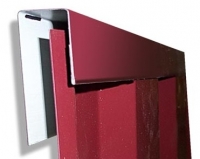 The overlay will give the fence an aesthetic look and will prevent users from damaging the sharp edges of the sheet.
The overlay will give the fence an aesthetic look and will prevent users from damaging the sharp edges of the sheet.
The strip is simply put on the sheet, so when ordering, pay attention to its width.
For corrugated board with a wave height of 8 mm, you need a strip 10 mm wide (including rolling) or 8 mm (without rolling).
We draw your attention to the fact that the professional flooring of most manufacturers is painted in color only on one side. The unpainted gray side looks towards the house. If you plant trees, shrubs or grapes along the fence, this will hide an unpresentable view of the fence.
Stage 5. Cleaning the territory after the construction of the fence
Cleaning - logical conclusion construction process... Cleaning is necessary in order to avoid injury by scraps of corrugated board, scattered self-tapping screws and to give the site a well-groomed look.
Installing a fence made of corrugated board with your own hands - video
Installation of corrugated fences - price for work and material
| Material | The cost of a fence made of corrugated board
subject to DIY installation |
The cost of installing a fence made of corrugated board
subject to the involvement of employees |
|---|---|---|
| Corrugated board | 140-680 rubles / sq. M. | |
| Pipe 60x60x2 | 110 rub / r.m. | |
| Pipe 40x40x2 | 70 rubles / r.m. | |
| Pipe 40x20x2 | 60 rubles / r.m. | |
| Plate holder | Rub 80-150 / pc. | |
| Pole cap | RUB 1.7-59 / piece | |
| Hardware (self-tapping screw) | US $ 2.5-5.3 / piece | |
| RUB 180 / pc (balloon) | ||
| End plate (2000 mm) | RUB 60-110 / pcs. | |
| Cement | RUB 175/50 kg. | |
| Sand | 80 rubles / 50 kg. | |
| Gravel, fraction 20-40 mm. | RUB 100/40 kg. | |
| Stainless steel primer - alkyd primer for metal | RUB 210 / kg. | |
| Foundation device | 0 | RUB 5,000 per sq.m. (the cost is influenced by the type of soil) |
| Drilling a hole or driving a pile | 0 | From 200 rubles / piece |
| Concreting support pillars | 0 | From RUB 500 / pc. |
| Mount lag | 0 | From 50 rubles / r.m. |
| Fastening a sheet of corrugated board | 0 | From 200 rubles / r.m. |
The total costs of building a fence made of corrugated board are determined based on the need for a particular type of material.
The cost of installing a “turnkey” corrugated board fence (price per meter of work, materials with installation) is shown in the table.

Conclusion
A fence made of corrugated board looks great, withstands any temperature extremes and all types of atmospheric phenomena. But there are two weak points - windage and poor-quality installation. We hope that the information provided here will allow us to take into account and promptly eliminate both of these shortcomings.
The construction of corrugated fences is a common method of fencing a site. This fence goes well with any landscape. Manufacturers produce canvases in various colors.
We will tell: how to correctly make a fence from a professional sheet with your own hands, we will tell about the features of different designs, we will describe step by step instructions. In the article you will find answers to the questions: how to make a fence from a profiled sheet with metal, stone and brick supports.
Building materials
To install a fence yourself, you need to prepare certain building materials:
- Polymer corrugated board... It can be painted on one or both sides. The material is coated with a polyester compound, which ensures a long product life. Do not purchase galvanized profiled sheets. They have one advantage - the price, while the galvanized coating quickly becomes covered with rusty spots. On a sunny day, such a fence will further raise the temperature. If you plan to put a two-meter fence made of corrugated board with your own hands, while the foundation will be installed as a basis, subtract the height of the base from the planned height (2 meters). The difference is the height of the profiled sheets that you need to purchase. The distance between the posts is the width of the span of the corrugated sheets. If you do not know how to install the poles, we recommend placing them at a distance of 2.5 - 3 m from each other.
- Support... The pipes are metal, round, rectangular or square. On request, stone or brick posts are installed as supports. Brick supports look much more attractive than metal ones. For the installation of non-metallic pillars, decorative bricks, stone, cement and sand are used. What pillars are needed for maximum strength designs? Metal supports should be 40 x 60 mm or 60 x 60 mm. Then the structure will withstand loads of different strengths.
- Metal lags - they are necessary for the transverse fastening of the corrugated board. Optimum logs are 20 x 20 mm. The technology of building a fence with a height of 2 meters or more involves two rows of logs. Otherwise, the structure may deform due to physical impact.
- Mountings (or dowels for installation). With their help, you can fix the professional sheet on the fence.
Stone, sand, crushed stone (screening), cement - will be needed to create a foundation. To correctly build a fence from a profiled sheet, you need to install it on the foundation. Without a quality foundation, the fence will not last long. Vegetation, soil leaching, animals can deform the structure over time, and the foundation will prevent this possibility.
We already wrote in more detail about what types of foundations exist in the article:, types and methods of filling.
Tools for work
When we build a fence from a professional sheet with our own hands, we need the following tools:
- Sledgehammer.
- Shovel.
- Roulette.
- Cord.
- Level.
- Welding machine.
If the tools and materials for construction are prepared, we proceed to the construction of a fence from a profiled sheet.
How to build a fence?
Stages of work:
- Territory marking and calculation of materials.
- Installation of the foundation and columns (installation of support pillars in a fence without a foundation).
- Installation of corrugated board on logs.
Before building a fence from corrugated board, we mark the territory and collect the site data. How to do it correctly, we wrote.
At the corners of the future fence we hammer in the pegs, between which we stretch the thread. Along it, you need to put marks where the pillars or metal supports will stand.
The construction of fences from a profiled sheet in an area with a slope assumes a stepped structure. We check the height and evenness of the steps using a level.
We calculate the number of columns that will be installed. To do this, divide the length from the corner to the next one by 2 to 3 meters. These will be spans. It is necessary to make markings for gates, wickets and take these additional supports into account when purchasing material.
By the type of construction, the fence made of profiled sheet is of the following types:
- Fence without foundation. A sheet of corrugated board is placed along the height of the fence.
- Constructions.
Building a fence from a profiled sheet without a foundation is less expensive. In addition, the installation is carried out faster, but the second option looks more respectable, although it requires more costs for materials, funds, labor resources.
Construction of a fence with metal posts
In order to correctly put a fence made of corrugated board, where pieces of metal pipes will be used as pillars, we do the following:
- We put corner posts in places of marking. To correctly make a fence from a profiled sheet, we advise you to immerse the pole in the ground by a third of the length, in this case, maximum wind resistance is created. Fill the recesses with concrete.
- We organize the formwork. In this way, a board is created that connects adjacent posts. The width of the formwork depends on the wishes of the owner, but the side looks aesthetically pleasing, about 20 centimeters wide. If we build a fence made of profiled sheet with formwork, it will last longer.
- We set markings along the length of the structure, at a distance of 2 - 3 meters. Pull the thread between the corner columns.
- We dig in the columns according to the markings. Do-it-yourself construction of a fence from a profiled sheet involves the installation of pillars at the same distance.
- Pour the concrete mixture into the formwork container. Additionally, we compare the accuracy of the transverse, longitudinal and vertical columns. We leave the structure to dry completely.
- We weld the transverse strips to the finished structure. To put a fence from a profiled sheet correctly, you need to check the evenness of the structure with a building level.
- We attach the corrugated board to the transverse logs. For reliable fixation we use self-tapping screws for metal. We advise you to select fasteners that match the color of the sheets.
Important: Pay special attention to attaching the first sheet. The appearance of the entire structure depends on how smoothly it will be attached. After all, each subsequent professional sheet is attached to the previous one. It is necessary to make an overlap, the size of one wave.
Installation of pillars made of brick and stone
Building metal fences from corrugated board with brick columns involves the creation of formwork for the future foundation.
The brick layer is built using reinforcement. The metal parts are arranged in an upright position and covered with bricks.
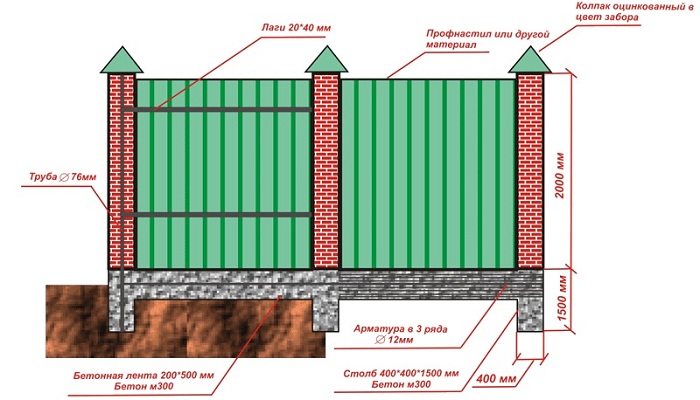
Do-it-yourself construction of a fence made of corrugated board with brick columns cannot be done without reinforcement... Brick is a fairly heavy material. Metal lintels will only strengthen the load on the foundation, which can collapse over time under the influence of gravity. If we make a fence from a professional sheet with our own hands, it is imperative to reinforce the foundation layer.
- We lay out the pillars and intermediate jumpers with bricks. If the height of the fence is standard, we install the brackets into the posts at a height of 20-30 and 1.50-1.60 m from the ground, where the horizontal strips will be welded. We periodically check verticality with a level.
- We weld horizontal strips to the embedded parts. It is advisable to paint the metal parts. This will help prevent future corrosion.
- With the help of self-tapping screws, we fasten the profile structures. You can use rivets and attach them with a special rivet.
The peculiarity of the construction of a fence made of profiled sheet with brick columns implies the creation of a roof for each column. The structure will not be affected by precipitation and weather conditions (snow, rain, wind).
More detailed instructions with video tutorials and images for installing fences exactly with brick pillars presented in this article:?
Video
You can see how to build a fence from a professional sheet with your own hands in this video:
Designers advise installing a do-it-yourself fence made of corrugated board with columns for finishing the facade. It looks stylish and emphasizes the status of the owners. On the back side, it will be appropriate to build a fence with metal columns.
We determine which option suits us more, and put up a fence. As you can see, it is quite possible to build a fence from a professional sheet with your own hands, and videos, photos and detailed instructions will help you achieve your goal.
Fencing suburban area, the construction of a fence is one of the first tasks on the list that needs to be solved by a summer resident who is engaged in arranging his site. To hide the area from prying eyes, you can make a practical do-it-yourself fence from corrugated board. In this article, we will consider how to build this fence, paying close attention to the various nuances and secrets of installation.
Why exactly corrugated board?
A fence made of this material can be quickly installed - the desired line along the perimeter is determined, the posts, transverse posts are installed, and then the profiled sheets are attached. Behind such a fence, the owners feel comfortable - it protects from prying eyes, being quite strong.
A metal profile fence can be made high. At a height of 3-5 m, it will be impossible to look behind the fence. Such a fence will also muffle sounds coming from the outside, create a kind of sound-reflecting screen for the sounds produced on the site.
A fence from a professional sheet is a feasible task that can be solved without the involvement of specialists and additional costs for their work or rental of special equipment, as required, for example, during installation concrete fence... You must, of course, purchase necessary tools and have the skill of working with a professional sheet. The sheet is also good because it is produced in various colors. You can choose the color according to your taste and make it neat beautiful fence... Moreover, such a fence will serve you for a long time - galvanized profiled sheet has a service life of up to 20 years, and covered with polymers can last much longer.
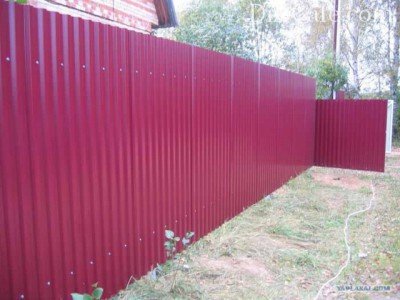
The color of the fence can go well with the decoration of the house, enliven the landscape. A fence made of a professional sheet is not a dull and faceless structure, even in the very simple version he pleases the eye
When buying professional sheets, be sure to pay attention to the price - you should not save here. The low price speaks of the same quality - poor quality of rolled products, polymer layer, galvanizing, or too thin metal that is not suitable for fence.
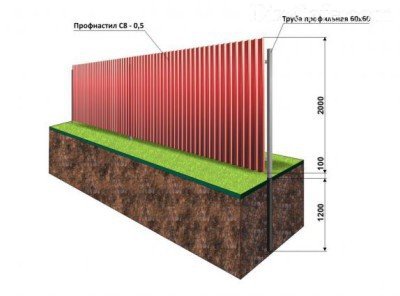
When choosing a sheet, do not pursue cheapness, the fence is being built for more than one year. C8 corrugated board is excellent for both roofing and fence construction
To install a fence from a profiled sheet, you will need the following materials:
- corrugated board + pipes for support pillars and pipes for logs;
- crushed stone + cement + sand;
- rope, primer, level;
- welding machine + container for cement mortar;
- drill + drill;
- riveter + rivets or self-tapping screws for metal.
Poles can also be used asbestos-cement or wooden. If you opted for wooden posts, treat them with an antiseptic before starting work. The part that will be buried must be especially durable - it can be treated with a blowtorch and then with a bituminous primer.
Step-by-step analysis of construction stages
At the first stage, it is necessary to make accurate markings - to determine where the gate, the gate will be located, to outline the places for the pillars. The poles are installed at a distance of no more than three meters from each other. Determine the desired height of the perimeter fence to calculate the amount of material required.
Stage # 2 - installing support pillars
These can be pipes with a square (not less than 50 / 50mm) or round section (not less than 76 mm). The top holes can be welded to keep moisture out.
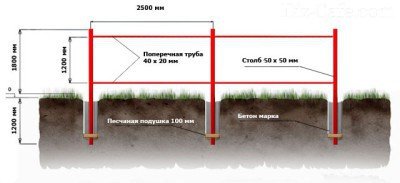
Installation diagram of supports for a fence made of corrugated board. Metal pipes are used as supports; rubble can be poured into the bottom of the pits or made sand pillow... Installation on two logs.
Next, you need to dig holes for posts 1-1.5 m deep, 150 mm wide. You can use a hand drill. The deepening of the underground part of the supports depends on the height of the fence, the higher the fence is planned, the greater the depth of the support you need to dig in.

Installation diagram of a fence made of corrugated board in three logs. Profile pipes are used as support pillars and logs
The poles must be well reinforced, because such a fence is subject to wind force. If the supports are poorly strengthened, the fence, a large area of \u200b\u200bwhich is exposed to the wind, may partially topple over. The bottom of the holes for the pillars is filled with medium-gravel gravel (layer about 150-200 mm), then the pillar is installed, cement mortar is poured.
Note! To install the pillars, you need to use a plumb line, they must be installed strictly vertically. For good fixing of the supports, they can be strengthened by welding metal rods on both sides and burying them in the ground. After the supports are filled with mortar, they must be left for three days for the concrete to completely harden.
When the foundation hardens, we proceed to the installation of the lag - the steel transverse profile is mounted to attach the profiled sheet to it. A profiled pipe (section 40/25 mm) is suitable for lag. The number of lags in each section depends on the height of the fence. At a height of 1.7 m, two logs are enough, at a height of 1.7 - 2 m and above, you will need to install three logs - above, below and in the middle. The upper and lower joists are installed at a distance of 4 cm from the top and from the edge of the ground. Electric welding for fixing them is the most reliable way of fixing. To protect against rust, the logs and posts are coated with a special primer after installation. It is better to do this at this stage, since after installing the sheets, it will be very inconvenient to work with the primer.
The installation of the fence also depends on the type of soil. If the soil is soft, some parts of it, especially in springtime, may sag, the same will happen with the posts installed in such soil. In soft soil, it is better to build a strip foundation for installing the posts. It is built like this - a tape box is made along the pillars along the bottom. The height of the box is about 20 cm, so that it is strong, the boards are fastened with bars or wire. Then we lay a waterproofing layer along the walls of the structure, fill it with concrete. Even if the soil near the supports is eroded, the strip foundation will give strength and stability to the fence.
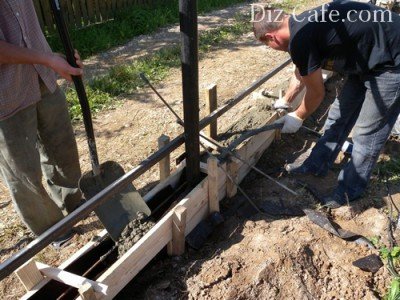
We build a strip foundation for a fence from a profiled sheet installed in soft soil. The box is fixed between the bars, after filling with cement, a very strong and reliable structure will turn out, you can not be afraid of such a fence
Stage # 3 - install the corrugated board on the logs
For fastening we use self-tapping screws for metal (length 35 mm, pitch 500 mm). Docking sheets of corrugated board with each other is overlapped.
Advice! When installing a fence made of corrugated board, use working gloves - the corrugated sheet is a fairly sharp material, there is a risk of injury.
As they say, it's better to see once than hear a hundred times. We offer you to watch a video with an example of editing:
A fence made of corrugated board looks good, it is durable and practical, the material easily tolerates difficult weather conditions, sudden temperature changes, extreme heat and cold. Therefore, do not treat such a solution as temporary. If the pillars that do not look particularly aesthetically pleasing are revetted with brick or stone (or use a colored sheet), then the fence will look expensive and beautiful.
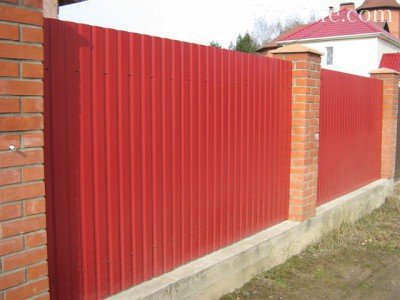
Alternatively, the supports can be faced with artificial or natural stone or brick - such a fence looks much more impressive and is much more durable. But, of course, this will require considerable additional costs.

The corrugated board goes well with other materials, for example, forging. In this version of the fence, the corrugated board covers the upper part of the fence, you can close only the lower one or use sheets with a gap between them - you will get an original attractive fence
When installing a fence made of corrugated board, scratches on the sheets are almost inevitable. They can be easily disposed of with a spray paint can. It is better to buy a couple of cans of paint of a suitable color in advance. From the outside, the fence looks like a solid wall, without seams, strong and reliably hiding the yard from prying eyes.
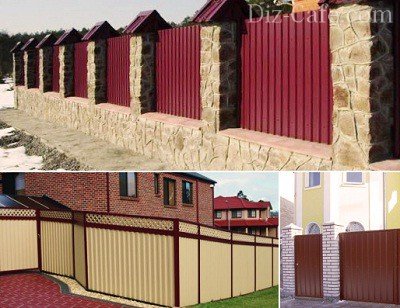
Various options for fences made of corrugated board demonstrate the aesthetics of this material, its good compatibility with both stone and brick. It is enough to show a little imagination to create not only a practical, but also a beautiful fence.
Additional spending on the maintenance of such a fence is not required, which cannot be said about, and this is another plus in favor of installing a fence from a professional sheet.



